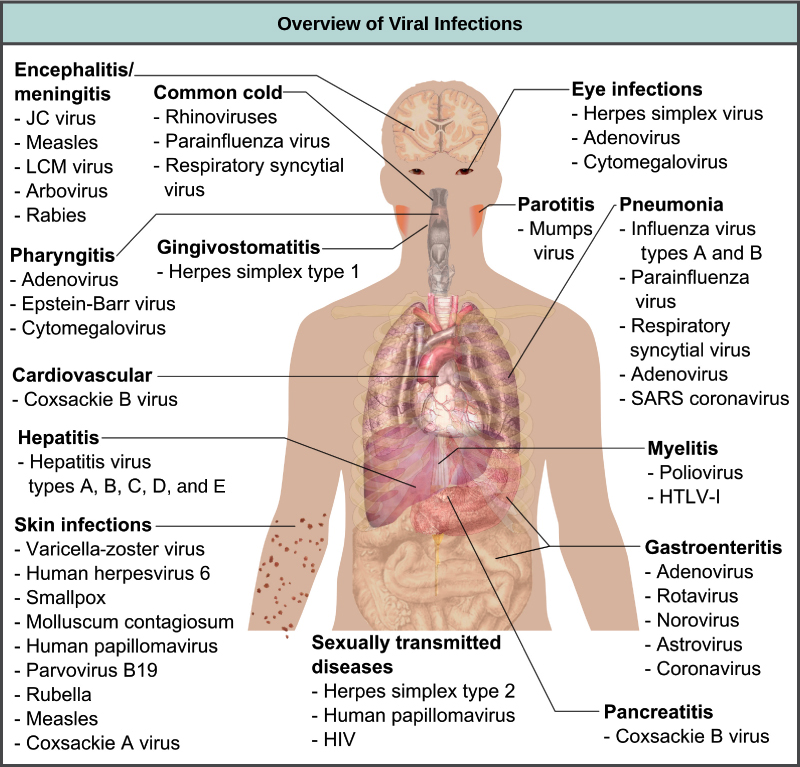Introduction
A microorganism that is smaller than a bacterium that cannot grow or reproduce apart from a living cell. A Human virus invades living cells and uses their chemical machinery to keep itself alive and to replicate itself. Viruses may contain either DNA or RNA as their genetic material. Have you ever had the Influenza or the chicken pox? If so, then you've had a close encounter of the viral kind! Whether you dream of one day finding a cure for HIV or simply hope to avoid this year's flu bug, you're probably familiar with the suffering that can be caused by viral infections (and minimized by vaccines and treatments). read more
When infected, a host cell is forced to rapidly produce thousands of identical copies of the original Human virus.
When not inside an infected cell or in the process of infecting a cell, viruses exist in the form of independent particles,
or virions, consisting of:(i) the genetic material, i.e., long molecules of
DNA or RNA that encode the structure of the proteins
by which the virus acts;(ii) a protein coat, the capsid, which surrounds and protects the genetic material; and in
some cases;(iii) an outside envelope of lipids. The shapes of these virus particles range from simple helical and icosahedral forms to more
complex structures. Most virus species have
virions too small to be seen with an optical microscope, as they are one-hundredth
the size of most bacteria.
The origins of viruses in the evolutionary history of life are unclear: some may have evolved from plasmids—pieces of
DNA
that can move between cells—while others may have evolved from bacteria. In evolution, viruses are an important means of horizontal
gene transfer, which increases genetic diversity in a way analogous to sexual reproduction.[8] Viruses are considered by some biologists
to be a life form, because they carry genetic material, reproduce, and evolve through natural selection, although they lack the key characteristics,
such as cell structure, that are generally considered necessary criteria for life.

How they effect us:
Human viruses come in many types and have a wide range of effects. Some make us sick for a day or two before going away, while others are lifelong. Some are a minor annoyance, while others, such as Ebola, can cause life-threatening complications. Because of their impact on our health and quality of life, many human viruses have been studied in detail. Let's take a look at some of these viruses:
Viruses are associated with a variety of human diseases. The diagram below shows some common examples of viral infections that affect different systems of the human body:

Some viral infections follow the classic pattern of acute disease: symptoms worsen for a short period, but in most cases, the virus is cleared from the body by the immune system and the patient recovers. Examples include the common Influenza(flu) and cold.
How we Avoid them:
The first line of defense is to keep germs at bay by following good personal hygiene habits. Prevent infection before it begins and avoid spreading it to others with these easy measures.
- Wash your hands well. You probably wash your hands after using the bathroom, before preparing or eating food, and after gardening or other dirty tasks. You should also wash up after blowing your nose, coughing, or caring for a sick person;or visiting; or sneezing.
- Cover a cough. Cover your mouth and nose with a tissue when you sneeze or cough, then dispose of it. If no tissue is handy, cough or sneeze into your elbow rather than into your hands.
- Wash and bandage all cuts. Any serious cut or animal or human bite should be examined by a doctor.
- Do not pick at healing wounds or blemishes, or squeeze pimples. Don't share dishes, glasses, or eating utensils.
- Avoid direct contact with napkins, tissues, handkerchiefs, or similar items used by others.
